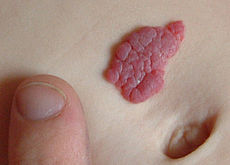- Capillary hemangioma
-
Capillary hemangioma Classification and external resources 
A small hemangioma of infancyICD-10 D18.0, Q82.5 (ILDS D18.015) ICD-9 757.32 ICD-O: 9131/0 DiseasesDB 30032 eMedicine oph/691 MeSH D018324 A capillary hemangioma (also known as an "Infantile hemangioma,"[1] "Strawberry hemangioma"[2]:593, and "Strawberry nevus"[1]) appears as a raised, red, lumpy area of flesh anywhere on the body, though 83% occur on the head or neck area.[3] These marks occur in about 10% of all births[4]:81, and usually appear between one and four weeks after birth.[5] It may grow rapidly, before stopping and slowly fading. Some are gone by the age of 2 , about 60% by 5 years, and 90–95% by 9 years.[5] Capillary hemangioma is a vascular anomaly.
Capillary hemangiomas occur 5 times more often in female infants than in males, and mostly in Caucasian populations.[6][3] Additionally, low birthweight infants have a 26% chance of developing a hemangioma.[6][3]
It is the most common tumor of orbit and periorbital areas in childhood. While this birthmark may be alarming in appearance, physicians generally counsel that it be left to disappear on its own, unless it is in the way of vision or blocking the nostrils.[5]
See also
References
- ^ a b Rapini, Ronald P.; Bolognia, Jean L.; Jorizzo, Joseph L. (2007). Dermatology: 2-Volume Set. St. Louis: Mosby. ISBN 1-4160-2999-0.
- ^ James, William; Berger, Timothy; Elston, Dirk (2005). Andrews' Diseases of the Skin: Clinical Dermatology. (10th ed.). Saunders. ISBN 0721629210.
- ^ a b c "Hemangioma Information". Vascular Birthmark Foundation. http://www.birthmark.org/hemangiomas.php. Retrieved 2008-08-02.
- ^ Sadler, Thomas W. (2009). Langman's Medical Embryology. (11th ed.). Lippincott Williams & Wilkins. ISBN 1-6054-7656-0.
- ^ a b c "Birthmarks". Parenting and Child Health website. http://www.cyh.com/HealthTopics/HealthTopicDetails.aspx?p=114&np=304&id=1589. Retrieved 2008-08-02.
- ^ a b "Birthmarks". American Academy of Dermatology. http://www.aad.org/public/publications/pamphlets/common_vascular.html. Retrieved 2008-08-02.
Vascular tissue neoplasm (ICD-O 9120–9179) (C49+C46/D18, 171+176/215) Blood Hemangioma/hemangiosarcoma · Blue rubber bleb nevus syndrome · Hemangioendothelioma (Infantile hemangioendothelioma · Endovascular papillary hemangioendothelioma · Epithelioid hemangioendothelioma · Spindle cell hemangioendothelioma · Composite hemangioendothelioma · Proliferating angioendotheliomatosis · Retiform hemangioendothelioma) · Hemangiopericytoma · Angiokeratoma · Capillary hemangioma (Hemangioblastoma) · Cavernous hemangioma · Venous lakeKaposi's sarcoma: African cutaneous Kaposi sarcoma · African lymphadenopathic Kaposi sarcoma · AIDS-associated Kaposi sarcoma · Classic Kaposi sarcoma · Immunosuppression-associated Kaposi sarcoma · Kaposiform hemangioendotheliomaAngioma serpiginosum · Cherry angioma · Glomeruloid hemangioma · Microvenular hemangioma · Spider angioma · Targetoid hemosiderotic hemangioma · Tufted angioma · Universal angiomatosis
Pyogenic granulomaLymphatic Lymphangioma/lymphangiosarcoma · PEComa (Lymphangioleiomyomatosis) · Cystic hygroma · Lymphangioma circumscriptumEither Congenital malformations and deformations of integument / skin disease (Q80–Q82, 757.0–757.3) Genodermatosis Congenital ichthyosis/
erythrokeratodermiaADARUngroupedIchthyosis bullosa of Siemens · Ichthyosis follicularis · Ichthyosis prematurity syndrome · Ichthyosis–sclerosing cholangitis syndrome · Nonbullous congenital ichthyosiform erythroderma · Ichthyosis linearis circumflexa · Ichthyosis hystrixEB
and relatedJEB (JEB-H, Mitis, Generalized atrophic, JEB-PA)related: Costello syndrome · Kindler syndrome · Laryngoonychocutaneous syndrome · Skin fragility syndrome ·Naegeli syndrome/Dermatopathia pigmentosa reticularis · Hay–Wells syndrome · Hypohidrotic ectodermal dysplasia · Focal dermal hypoplasia · Ellis–van Creveld syndrome · Rapp–Hodgkin syndrome/Hay–Wells syndromeEhlers–Danlos syndrome · Cutis laxa (Gerodermia osteodysplastica) · Popliteal pterygium syndrome · Pseudoxanthoma elasticum · Van Der Woude syndromeHyperkeratosis/
keratinopathydiffuse: Diffuse epidermolytic palmoplantar keratoderma • Diffuse nonepidermolytic palmoplantar keratoderma • Palmoplantar keratoderma of Sybert • Mal de Meleda •syndromic (connexin (Bart–Pumphrey syndrome • Clouston's hidrotic ectodermal dysplasia • Vohwinkel syndrome) • Corneodermatoosseous syndrome • plakoglobin (Naxos syndrome) • Scleroatrophic syndrome of Huriez • Olmsted syndrome • Cathepsin C (Papillon–Lefèvre syndrome • Haim–Munk syndrome) • Camisa diseasefocal: Focal palmoplantar keratoderma with oral mucosal hyperkeratosis • Focal palmoplantar and gingival keratosis • Howel–Evans syndrome • Pachyonychia congenita (Pachyonychia congenita type I • Pachyonychia congenita type II) • Striate palmoplantar keratoderma • Tyrosinemia type II)punctate: Acrokeratoelastoidosis of Costa • Focal acral hyperkeratosis • Keratosis punctata palmaris et plantaris • Keratosis punctata of the palmar creases • Schöpf–Schulz–Passarge syndrome • Porokeratosis plantaris discreta • Spiny keratodermaungrouped: Palmoplantar keratoderma and spastic paraplegia • desmoplakin (Carvajal syndrome) • connexin (Erythrokeratodermia variabilis • HID/KID)OtherMeleda disease · Keratosis pilaris · ATP2A2 (Darier's disease) · Dyskeratosis congenita · Lelis syndromeDyskeratosis congenita · Keratolytic winter erythema · Keratosis follicularis spinulosa decalvans · Keratosis linearis with ichthyosis congenital and sclerosing keratoderma syndrome · Keratosis pilaris atrophicans faciei · Keratosis pilarisOthercadherin (EEM syndrome) · immune system (Hereditary lymphedema, Mastocytosis/Urticaria pigmentosa) · Hailey–Hailey
see also Template:Congenital malformations and deformations of skin appendages, Template:Phakomatoses, Template:Pigmentation disorders, Template:DNA replication and repair-deficiency disorderDevelopmental
anomaliesMidlineOther/ungroupedAplasia cutis congenita · Amniotic band syndrome · Branchial cyst · Cavernous venous malformation
Accessory nail of the fifth toe · Bronchogenic cyst · Congenital cartilaginous rest of the neck · Congenital hypertrophy of the lateral fold of the hallux · Congenital lip pit · Congenital malformations of the dermatoglyphs · Congenital preauricular fistula · Congenital smooth muscle hamartoma · Cystic lymphatic malformation · Median raphe cyst · Melanotic neuroectodermal tumor of infancy · Mongolian spot · Nasolacrimal duct cyst · Omphalomesenteric duct cyst · Poland anomaly · Rapidly involuting congenital hemangioma · Rosenthal–Kloepfer syndrome · Skin dimple · Superficial lymphatic malformation · Thyroglossal duct cyst · Verrucous vascular malformation · BirthmarkCategories:- Cutaneous congenital anomalies
Wikimedia Foundation. 2010.
